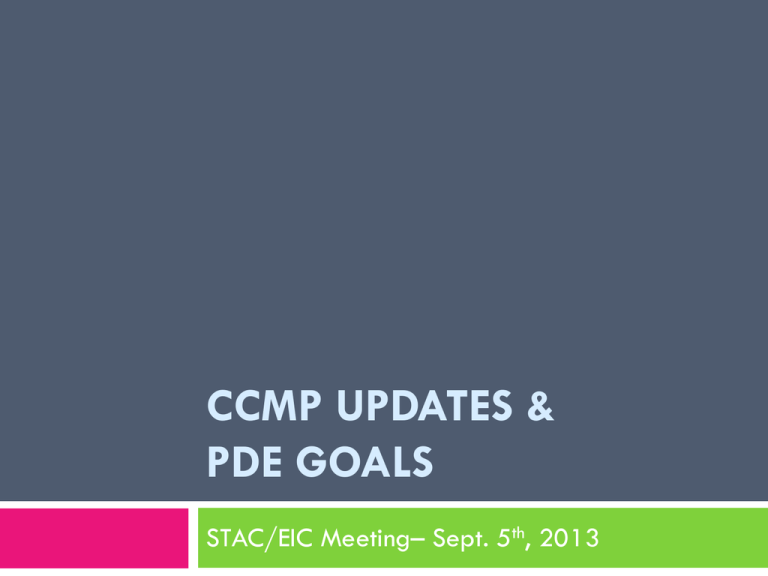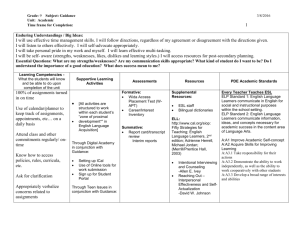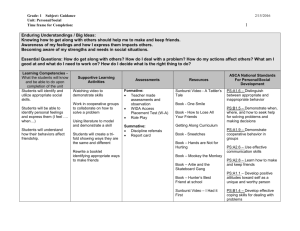PDE Goals & CCMP updates
advertisement

CCMP UPDATES & PDE GOALS STAC/EIC Meeting– Sept. 5th, 2013 Ground Rules Agenda Time: 1.5 Hour No comments until after the presentation! Schedule a Call with Priscilla Origins: Delaware Estuary Program 1988 - Delaware Estuary was nominated by the three state governors for inclusion into the National Estuary Program 1990 - Delaware Estuary joined the National Estuary Program Original Partners: EPA, DRBC, NJ, PA, DE, NOAA, USACE 1996 - Comprehensive Conservation and Management Plan (CCMP) PA, DE, NJ Management Division Reorganization in 2005 DELEP Partnership for the Delaware Estuary (PDE) Science Policy Restoration Education Fundraising Coordinate dozens of partners (Agency, NGO, Academic, Corporate) DRBC Oversee Management Plan (CCMP) Water Quantity & Quality Monitoring State of the Estuary Advisory Committees States Various: Restore habitat, Monitoring, Land management, etc. Where is the Management Plan Now? PDE annually reports CCMP implementation to EPA State of the Estuary Reports: 1996, 2002, 2008, 2012 CCMP Updates (est. 2013-2014) EPA Requirement – Measurable Goals for the Delaware Estuary Updating the CCMP Category STAC/EIC feedback from 2012 workshop Website to contain updates Roll out – Winter 2013 Action Ref. Status CCMP Original Update H7 Needs updating Protect Littoral Habitats from Sea Level Rise Threats Refresh language to reflect current climate program & partner efforts Badge & Mascot E21, E22 Not relevant Create Estuary Environmental Badge & Mascot Delete CCMP Actions Wetlands H4 Needs updating Coordinate/Enhance Wetlands Management New wetland monitoring programs & restoration Climate PDE Measurable Goals Healthy Waters Toxics, Nutrients, Dissolved Oxygen, Flow, Salinity Healthy Communities Brownfields, Public Access, Ecotourism, Urban Forests, Public Participation, Estuary Engagement 1. Healthy Habitats 1. Wetlands, Forests, Riparian Buffers, Fish & Shellfish Progress Update Year Date Activity 2013 Oct. 3 Steering Committee 2013 Aug 22Sept 26 STAC/EIC – Final Review Period 2013 Sept. 5 STAC/EIC Meeting 2013 June 6 Toxics Advisory Committee Meeting 2013 Feb-July STAC Committees/Webinars/Interviews 2013 Jan. 28 Delaware Estuary Science & Environmental Summit - Polling 2012 Oct. 11 Steering Committee (13 Goals Accepted) 2012 Oct. 1-2 STAC/EIC Workshop 2012 JuneSept STAC Committees Goals: Healthy Habitats Wetlands, Forests, Riparian Buffers, Fish & Shellfish Goals: Healthy Habitats Healthy Habitats = Measure – short term Measure – long term Responsible Agencies: Assumptions/ Needs Functioning wetlands PDE, EPA, States, USFWS, NOAA - Sustain MACWA to track wetland acreage and health - Establish wetland regional body - Develop estuary-wide baseline for health by 2020 Contiguous/ connected forests Healthy fish and shellfish habitat Get a robust tidal wetland monitoring program with a regional body for coordination and consistency of tracking wetland health in place by 2020 Develop estuary-wide baseline for tidal wetland health by 2020 and goals to sustain tidal wetland health by 2022. Identify and implement tactics to maintain high value tidal wetlands and limit acreage loss to 5% of 2006 acreage by 2025 Stem forest loss to less than 1% per year by 2025 Develop metrics and tracking system for loss of buffers and connectedness by 2017 Secure dedicated funding of $1million or more per year for oyster shell planting by 2015 By 2017 define, map and inventory and by 2030 protect the following critical species habitat: o Mussel habitat (fresh and marsh) o Vegetated nursery habitat for fish & crabs, particularly in shallow intertidal areas o Beach habitat for horseshoe crabs o Critical bottom habitat for sturgeon (and other fish) Facilitate 1-2 fish passage projects per year Take aggressive action to limit net acreage loss of tidal wetlands to 15% of 2006 acres by 2040 Tidal wetland health TBD in 2022 based on short term actions No net loss of non-tidal wetlands TBD in/after 2025 based on short term actions States, USFW, USFWS, DRBC, EPA, TNC, NFS, USFS Field station, DVRPC Maintain or increase oyster beds at PDE, States, EPA, 2012 acreage with 25% increase in USFWS, NOAA, productivity by 2030 USCG, USACE, Increase freshwater mussel DRBC, ASMFC abundance and habitat by year and amount TBD based short term results Achieve goals established in recovery plans for Atlantic and short-nosed sturgeon to improve habitat Work with partners and existing tools to track forests - EPA cannot participate in solicitation of funding - Subject to completion of MOU with NJ Heritage Program to id/map mussel habitat - Collaborate with partners in the areas of sturgeon recovery, fish passage, and oyster recovery Goals: Healthy Communities Brownfields, Public Access, Ecotourism, Urban Forests, Public Participation, Estuary Engagement Goals: Healthy Communities Healthy Communities = Measure – short term Growth That Helps People and Living Resources Measure – long term Responsible Agencies: Assumptions/Needs: Assess and inventory urban waterfront brownfields (UWB) and public access opportunities by 2015 Prioritize and increase urban waterfront brownfield projects by 2017 Reclaim 50% of waterfront States, EPA, NOAA, brownfields to include DRBC, PWD, counties public access and living & municipalities, PDE shorelines/wetlands by 2050 - UWB = brownfields with frontage on tidal waters - Standardize use of term “brownfield” to align with EPA’s definition - Connect with existing brownfield partners to inventory, prioritize, and increase brownfield projects Restored/Protecte d Living Resources* Establish goals and measures to reconnect the public to natural resources through ecotourism, urban forests, and protected lands with public access by 2015 Sustain or enhance existing public access points in bayfront communities, and increase access points (relative to 2012) in underserved urban areas to reconnect communities to the water States, USFS, EPA, PWD, DRBC, USFW, counties & municipalities, PDE, UWFP Connect with other organizations and partnerships working on similar goals Public Understand- ing and Participation PDE marketing & communications plan completed by 2015 Begin implementing marketing/branding campaign by 2018 with means to measure results TBD between 2015 and 2018 based on PDE marketing and communications plan PDE, States, EPA, USFWS,NPS - Coordinate with partners to connect with other regional marketing and communication plans - Contract with marketing professions - Include assessing feasibility of using public polling to determine increase in affinity for Delaware River and Bay and its major tributaries in planning Goals: Healthy Waters Toxics, Nutrients, Dissolved Oxygen, Flow & Salinity Goals: Healthy Waters Healthy Waters = Measure – short-term Few or no toxic impacts Few or no nutrient impacts Flow to support drinking water and ecology Measure – long-term Assess the need for and establish biological endpoint criteria for contaminants of concern by 2020 Continue support for established monitoring programs, and achieve expansion of toxics monitoring with biological endpoints by 2025 Prioritize urban waterfront brownfield projects by 2015 Assess nutrient impacts on estuarine resources (e.g. wetlands and shellfish); establish criteria by 2015 and targets based on that assessment by 2020 Implement appropriate DO standards in Zone 2-6 for fish and other key aquatic species, with interim standards for existing use by 2015 and standards for highest attainable use by 2020.. Utilize model-derived benchmarks for flow management as they become available Establish and incorporate low flow/salinity benchmarks for natural balance and ecological highest attainable use in flow management by 2017 Responsible Agencies: Reduce PCB concentrations in DRBC, States, fish tissue by 25% by 2050 EPA, NOAA, (relative to 2013 levels) PDE Notes – Establishing new biological endpoints by 2020 will help to guide long-term reduction goals. Assumptions/ Needs: -Inventory existing toxics monitoring programs by 2015 -Conduct gap analysis of monitoring programs, funding needs -Identify relevant biological endpoints (eggs, blood, tissue, drinking water, etc.) by 2017 -Total load reduction of PCBs by ~25% by 2025 By 2030, estuarine resource endpoints show improvement from targeted nutrient reductions. Achieve highest attainable use for DO by 2030 DRBC, States, EPA, counties & municipalities, PDE Following EPA’s release of ammonia criteria, further assessment into other nutrient impacts Research nutrient impacts on shellfish (e.g. sediment ammonia and freshwater mussel erosion) Research nutrient impacts on wetlands by 2020 By 2025 achieve and maintain flow at benchmarks for drinking water and ecological highest attainable use in the face of changing watershed conditions, including climate change. DRBC, States, PWD, ACOE, NYC, water purveyors (WRADRB). PDE Biological inputs needed for flow model Goals: Comments Received Request to add The Nature Conservancy as a partner for two goals: Restored/Protected Living Resources and Public Understanding and Participation Request to remove climate change language from the Healthy Waters goals. Concerns raised about the “criteria setting” language in the Healthy Waters goals, especially with “establishing biological endpoint criteria by 2020” (Healthy Waters Row # 1) and “nutrient criteria by 2015” (Healthy Waters Row # 2); Request to consider replacing with language establishing metrics upon which eventual criteria would be based in the future.





